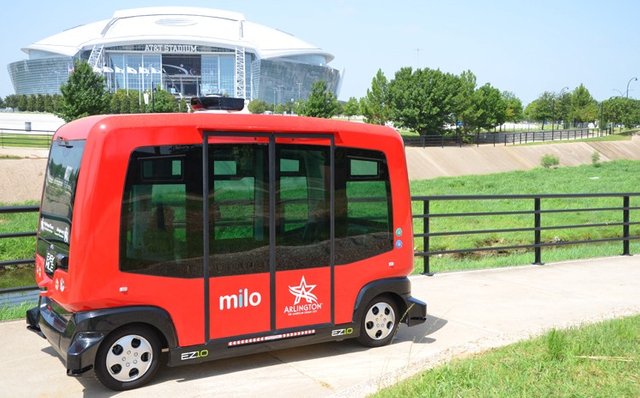
Elon Musk, Tesla’s rock-star chief executive, last week said that “self-driving will encompass all modes of driving by the end of the next year.” Musk’s fans were hanging on his every word, as he spoke at SXSW in Austin, but perhaps eyes should have been on San Ramon, Calif. where on March 6 an autonomous shuttle bus became the first vehicle to operate on California’s roads without a driver.
The key word is “public.” The EasyMile shuttle was traveling autonomously on active public roads. “This is the first driverless shuttle in California that DMV has granted this permission to, so it’s a really big deal,” commented DMV spokesperson Jessica Gonzalez. San Ramon — about 30 miles east of San Francisco — is in Contra Costa County, which hopes to have nearly 100 autonomous buses on its streets in about two years.
It’s one thing to hear optimistic predictions from carmakers and entrepreneurs, but it’s another matter to see concrete steps toward autonomous transportation taken by cautious municipal planners. More than 60 cities across the globe have established pilot zones, where for the first time everyday citizens can catch a ride in an autonomous vehicle. Easily achievable trips — mostly from self-driving shuttle buses traveling on fixed routes — are creating public trust in vehicles that don’t have a human being behind the wheel.
It’s a step-by-step process. Lab-based simulation and evaluations on private proving grounds have been conducted for decades. For more than five years, Google and others have been using public roads to test self-driving cars — but only with an engineer onboard. If you live in California, you will start to see self-driving cars whizz by without anybody in the car. California’s Department of Motor Vehicles in February announced that it will begin issuing permits for self-driving vehicles, such as the shuttle in San Ramon.

It’s Your Turn
We are entering a new phase, in which increasing numbers of travelers will be able to use an autonomous vehicle to get from A to B — even if for a short distance. The City of Austin was the first municipal government in the United States to offer autonomous shuttle rides to the general public on a continuous basis. The Easymile EZ10 shuttles carry passengers on a fixed 13-minute journey on a paved trail through a riverfront city park. And 200 miles to the south in Austin, the city council granted permission to use a driverless shuttle to link Austin Community College and a major transit corridor. Two other college campuses-the University of Michigan and the University of Florida in Gainesville-are also expected this year to launch driverless shuttle buses on fixed lines between their campus and local towns.
Meanwhile, across the pond in Lyon, France, the city has been operating a fleet of driverless shuttles for almost two years. That project was billed as the world’s first driverless bus service. Two electric minibuses carry up to 15 passengers each on a 10-minute route with five stops. In France’s Normandy region, commuters in Rouen will soon be able to use a smartphone to book specially-equipped versions of the Renault ZOE electric cars that can travel along a 17-stop circuit in a business campus. About 20 other cities in Europe are working on similar pilot projects to use robotic shuttles to augment public transit routes by connecting tourist zones, industrial parks, and local train stations.
The Vision Takes Shape
Pilot zones for driverless public transit are even bolder in Asia. Changhua County, on Taiwan’s urbanized west coast, in 2018 will open a five-mile corridor using eight driverless shuttles to connect one of the country’s largest parks to a nearby high-speed rail station. In Korea, the city of Seongnam will soon become the country’s first special district for autonomous-vehicle testing. And in an extraordinary glimpse into the future, a new 125-acre real estate development will dedicate three lanes of the main road for self-driving vehicles — leaving only a single lane for human-piloted cars.
In another project, NuTonomy — which was acquired by Delphi, a major auto supplier in October — is expected to launch an autonomous taxi service in Singapore by summer 2018. It doesn’t get more real than that unless you go to China’s Pearl River Delta region, which is home to a massive population of 50 million people. That’s where Pony.ai — a company with offices in Silicon Valley and China — in February became the first company to operate an autonomous ride-hailing service on public roads in China.
Pony.ai is using cars such as the Lincoln MKZ sedan on a two-mile route to evaluate road condition, weather, and unexpected behavior on crowded streets. The company said that it will produce up to 1,000 self-driving cars in 2018, and field hundreds of them as autonomous taxis in China’s central Anhui province.
The pilot zones described in this post is only a partial list. One by one, these programs are revealing the roadmap for self-driving vehicles. As these pilot zones grow and integrate with one another, we are witnessing the formation of a new global transportation platform take shape — with similarly robust activity for delivery robots, drones, and smart cities. The speed at which these pilot zones are growing inspires us every day at the DAV Foundation. The sense of urgency is palpable in our offices as we work to create a blockchain for these autonomous vehicles to discover one another and to operate in a cohesive, efficient global network.
Source: DAV Foundation, posts by Bradley Berman — Lead Editor
Hi! I am a robot. I just upvoted you! I found similar content that readers might be interested in:
https://medium.com/davnetwork/more-than-60-cities-across-the-globe-are-putting-autonomous-vehicles-on-public-roads-65894c68f3c5
Downvoting a post can decrease pending rewards and make it less visible. Common reasons:
Submit